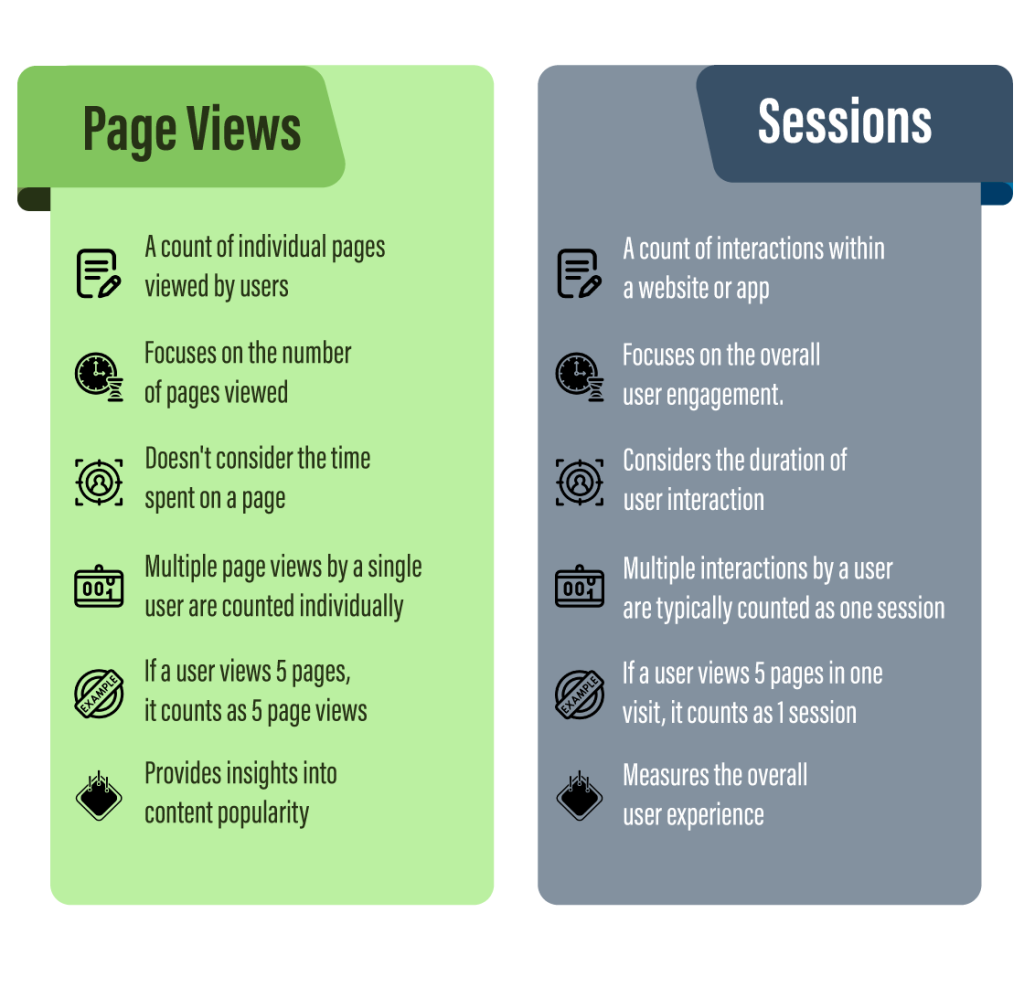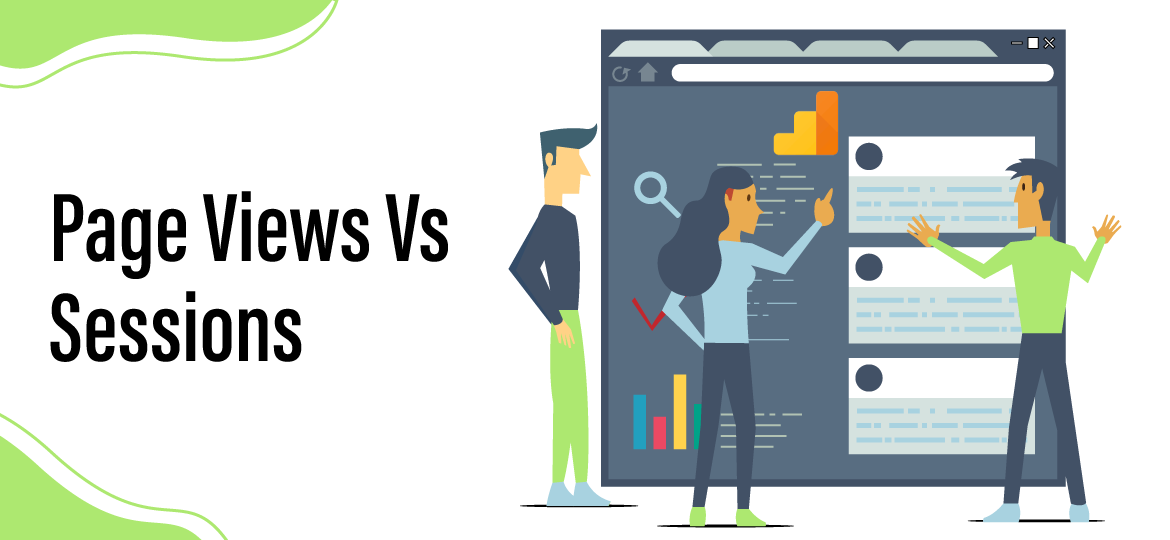Introduction: Why Analytics Still Matters in 2025
In 2025, Google Analytics 4 (GA4) is the backbone of digital marketing and SEO strategy for businesses across the USA. Whether you are running an eCommerce store, SaaS platform, mobile app, or enterprise website, understanding the difference between page views and sessions is critical for measuring traffic, conversions, and ROI.
With the latest Google SEO updates, mobile-first indexing, AI SEO tools, and voice search optimization, tracking how users interact with your iOS apps, Android apps, and websites has never been more important. This guide breaks down page views vs sessions, explains why they matter for your USA audience, and shows you how to optimize them for higher rankings and traffic in 2025.
What Are Page Views in Google Analytics?
A page view is counted every time a user loads or reloads a webpage. In GA4, this metric gives insight into content performance, engagement levels, and mobile app activity.
Why Page Views Matter in 2025
Help identify your most visited pages (blogs, landing pages, product pages).
Track mobile traffic trends (iOS and Android users).
Understand which content drives the most SEO clicks and conversions.
Measure engagement for USA-based audiences searching via mobile-first and voice search queries.
Example: If a user opens your iOS shopping app, visits a product page, and reloads it three times, that counts as 3 page views.
What Are Sessions in Google Analytics?
A session is a group of user interactions within a specific time frame (default 30 minutes in GA4). Sessions show user journeys, not just clicks.
Why Sessions Matter in 2025
Show how long users stay on your site or app.
Track multi-channel traffic (organic search, social media, mobile apps).
Measure engagement per session (pages visited, conversions, bounce rate).
Support SEO strategy by revealing what keeps USA users engaged longer.
Example: If a user opens your Android app, browses 5 product pages, and checks out, that is 1 session but 5 page views.
Page Views vs Sessions: Key Differences in 2025
| Feature | Page Views | Sessions |
|---|---|---|
| Definition | Each page load or reload | Group of interactions in 30 minutes |
| Measurement Focus | Individual page popularity | Entire user journey |
| Useful For | Tracking content performance | Understanding engagement & conversions |
| SEO Impact | Higher views = stronger relevance | Longer sessions = better ranking signals |
| Mobile Relevance | Tracks app screen loads | Tracks in-app user journeys |
Why Understanding the Difference Is Critical for SEO 2025
With Google’s Helpful Content Update and July 2025 Algorithm Update, user engagement metrics like sessions, time on site, and content depth now influence rankings more than ever.
High page views show content relevance.
Long sessions show strong engagement and user satisfaction.
Together, they improve your E-E-A-T signals (Experience, Expertise, Authoritativeness, Trustworthiness) in the eyes of Google.
For USA websites, balancing both metrics helps rank higher on Google, increase mobile traffic, and boost conversions.
Best Practices to Optimize Page Views and Sessions in 2025
1. Create Mobile-First Content
Since most U.S. traffic comes from iOS and Android apps or smartphones, optimize for mobile-first indexing and responsive design.
2. Use AI SEO Tools
Leverage AI-powered SEO platforms to analyze user journeys, predict search intent, and improve content targeting.
3. Optimize for Voice Search
Include long-tail conversational queries like “What’s the difference between sessions and page views in GA4?” to capture voice search traffic.
4. Improve Internal Linking
Guide users from one page to another to increase both page views per session and time on site.
5. Personalize User Experiences
Use AI + analytics to deliver personalized app recommendations, product suggestions, or blog content.
In the field of connected to the internet business and shopping, site owners and marketers use differing calculations to understand by what method well they are connected to the internet efforts. Two important metrics commonly secondhand in Google Analytics are Page Views Vs Sessions. Sessions show individual visits to your website, considering each opportunity someone comes, while Pageviews path by means of what many pages people examine.
These versifications are vital for making cognizant determinations and improving your connection to the internet demean or, helping you accept your hearing and by what method they engage accompanying your station. Whether you’re a webmaster or a seller, aware of how to use Sessions and Pageviews will guide you in optimizing your connection to the internet presence and realizing your aims.
Pageviews and Sessions Importance
Pageviews and sessions are fundamental web metrics, shedding light on user engagement and website performance. Discover their vital significance here.
Pageviews:
Pageviews are essential for understanding consumer data accompanying your content. They help you identify which pages are intriguing ultimate interest and which users are exploring your station exhaustively.
Sessions :
Sessions supply insights into consumer performance and the characteristics of their interplays. By following sessions, you can decide if users are verdict what they’re expecting, and whether they’re committed enough to survey diversified pages.
What Are Users?
Users are the things the one visit your site or use your app. Google Data labels users through wafers, admitting you to path their interplays over time. User are at the gist of understanding the impact and influence of your connected to the internet. presence. By separate user, you can resolve various consumer groups and tailor your content or marketing game plans respectively.
What Are Sessions?
Sessions represent the individual visits or interplays users have accompanying your home. They measure the progression of user data and help you believe the flow of guests through your site. Sessions are a valuable rhythmical for evaluating in what way or manner your scene captures and retains user consideration.
A meeting is a magnitude all along that a consumer interacts accompanying a site or netting use. It starts when a consumer lands on the site, either it’s the first page they visit or an after page, and it ends after an ending of inaction or when the consumer closes the internet /web viewing software or navigates external the site. A gathering can include believing multiple pages, interplays accompanying content, and miscellaneous projects, in the way that clicking on links or presenting forms.
What are pageviews?
Pageviews are a fundamental metric in network science and logical analysis that measure the number of periods a particular location on the world wide web is regarded or intoxicated by visitors on a site. Each time a caller opens a page in their netting internet or web viewing software, it registers as a pageview. Pageviews are important for understanding in what way or manner user communicate by accompanying your site’s content and guiding along a route, often over water.
What is a Unique Pageview?
A Unique Pageview in Google Analytics counts the number of sessions in which a specific web page was viewed at least once. It only counts one view per page per session, even if the user visits the page multiple times during the session. It’s useful for understanding the popularity and engagement of specific content on your website.
Also Read:
Sessions vs Pageviews:
Sessions
The Science of logic represents an ending of consumer interplay accompanying your site or app. It begins when a consumer lands on your section and ends subsequently an ending of inactivity or when they leave. Sessions are like individual visits to your ground, and they help you path in what way or manner many times users catch accompanying your content.
Pageviews
Pageviews, in another way., show the total number of pages viewed by user all the while their sessions. Each period a user loads a page, it counts as a pageview. Pageviews present you intuitions into that pages on your station are ultimate popular and by means of what user guide along the route, often over water. through your content.

How to Track Sessions and Pageviews in Google Analytics?
To track sessions in Google Analytics:
- Start by logging into your GA4 account.
- Choose the specific property you want to measure sessions for.
- On the left-hand menu, go to “Engagement,” and then click on “Sessions.”
- You’ll see a graph that illustrates the number of sessions over your selected time period.
If you want to find the total sessions, simply follow these steps:
- Click on “Reports.”
- Navigate to “Acquisition.”
- Select “Traffic acquisition.”
- Click on the “Sessions” header.
To get insights into engaged sessions, head over to “Acquisition” and then “User acquisition.” Here, you’ll find a chart that breaks down your engaged sessions by channel group.
Keep in mind that the default session timeout is 30 minutes. If you need to change this default timeout for web sessions, you can do so in the “Admin” section of Google Analytics.
To track pageviews in Google Analytics
- Begin by clicking on the Reports tab.
- Next, navigate to the Engagement section.
- Once there, select the Pages and screens option.
- In the Views column, you’ll find the total count of your pageviews.
- Don’t forget, you can fine-tune the timeframe by using the controls on the top-right corner of the screen. Besides pageviews, you can also access information about the number of users and views per user.
What is a good pages per session in Google Analytics?
A good number of pages per session in Google Analytics depends on several factors, including industry and other factors:
Content-Heavy Websites: Aim for 3-5 pages per session for blogs, news, or educational sites to show active engagement.
E-commerce Sites: 2-3 pages per session can be good; visitors quickly buy products.
Landing Pages: Lower pages per session are acceptable for single-page sites with specific conversion goals.
Niche Content: Specialized sites may see more pages per session due to user interests.
A “good” number of pages per session in Google Analytics depends on your website’s nature and goals. Pages per session represent the average number of pages viewed during one visit, reflecting user engagement
Also Read:
Google Analytics: Unveiling User Behavior
Following users in Google Science of logical analysis includes understanding the “Users” rhythm, which shows the unique things the one visits your website. Google Science of logical analysis does this by utilizing cookies, which are narrow pieces of data stored on a consumer’s tool. Here’s a means of directing users:
Start Google Data: Create a Google Analytics report and attach the tracking rule to your site.
Understanding the “Users” rhythm: In your Google Data reports, you can find the “User” metric, which supplies the total count of unique foreigners over a particular time period.
Separation: Google’s Science of logical analysis allows you to segment users based on various attributes, such as headcount, location, and demeanor. This separation helps you gain insights into various consumer groups.
Consumer Explorer: The Consumer Trailblazer feature in Google Analytics supports a particularized, individual-level view of user interactions on your station. It allows you to track a distinguishing consumer’s journey and actions.
Consumer-ID Pursuing: For a more advanced following, you can implement Consumer-ID Pursuing, which associates record-in user with their conduct across tools. This is particularly valuable for websites accompanying consumer accounts.
How To Improve Session Duration?
Session duration is a measure that measures by what method long users persist on your site all the while in a single meeting. To better the session event:
Superior Content: Provide charming, educational, and appropriate content that encourages users to survey your website.
Foolproof Guiding along the route, often over water: Ensure your site is smooth to guide along the route, often over water, and users can quickly find what they expect.
Internal Connecting: Use within links to guide users to add appropriate pages on your home, keeping the ruling class operating.
Page Load Speed: Optimize your site’s stowing speed to prevent users from leaving on account of slow accomplishment.
Clear Calls to Action (CTAs): Involve irresistible CTAs that encourage users to survey further or perform wanted conduct.
Movable Optimization: Confirm your site is mobile-intimate, as an increasing number of users approach sites on traveling schemes.
How To Increase Pageviews?
Within Connecting: Strategically link related content inside your site to entice users to survey more pages.
Content Approvals: Use content recommendation forms to desire additional items or devices for users.
Charming Head: Art compelling head and meta writings that encourage users to click and state more.
User: In the middle Design: Design your site to devote effort to something the user is doing, making it smooth for users to navigate along a route, often over water, and find what they want.
Common Content: Include mutual ingredients in quizzes, polls, and surveys to keep user busy and moving through your section.
Also Read:
Key Takeaways
When we pit Google Analytics sessions against pageviews, it becomes clear that sessions are the real MVPs in understanding how users interact with your website. While pageviews give us a glimpse into what’s popular, sessions take us on a deeper journey, showing us the full story of user engagement and interactions. So, if you’re looking to truly grasp user behavior, sessions are the way to go!
At EchoinnovateIt, we serve as a reliable resource for improving your online presence. Our Content Marketing Services, coupled with our extensive SEO knowledge, are designed to help you achieve success. Don’t hesitate to Reach out to us to enhance your digital marketing strategies!
FAQs
How many page views per session?
On average, it’s typically around 2 to 3 page views per session.
What is the difference between pageviews and sessions on Shopify?
Pageviews:
- Pageviews refer to the total number of times a specific page on your Shopify website has been viewed or loaded. Each time a visitor opens a page, whether it’s your homepage, a product page, a collection page, or any other page, it counts as a pageview.
Sessions:
- Sessions represent a single visit or interaction by a user on your Shopify store. A session can encompass multiple pageviews and interactions within a single visit. A session starts when a user lands on your website and ends after a period of inactivity (typically 30 minutes) or when the user leaves your site. During a session, the user can view multiple pages and perform various actions, such as adding products to their cart or making a purchase.
How do I increase pageviews per session?
- Improve Website Navigation.
- Display Related Products or Content.
- Cross-Sell and Upsell.
- Use Internal Linking.
- Create High-Quality Content.
- Optimize for Mobile Devices.
- Reduce Page Load Times.
- Implement Calls to Action (CTAs).
- Personalize Recommendations.
- Email Marketing.
- Social Sharing and Sharing Widgets.
- User Engagement and Interactivity.
How to increase SEO traffic?
- Optimize on-page SEO (keywords, meta tags).
- Create high-quality, relevant content.
- Build quality backlinks.
- Improve website speed and mobile-friendliness.
- Use descriptive URLs and headings.
- Optimize for featured snippets.
- Leverage social media and content promotion.
- Monitor and adapt to SEO trends.
What is the difference between page views and sessions in Google Analytics 2025?
Page views count each time a page (or screen in an app) is loaded, while sessions capture a user’s complete visit (all page views, interactions) within a set time (usually 30 minutes). Sessions show the user journey; page views show content popularity.
How do page views impact SEO for USA websites?
High page views often indicate which content is popular, helping Google understand what U.S. users find valuable. But to boost SEO in 2025, pairing page views with longer sessions, low bounce rates, mobile-friendly design, and E-E-A-T content is essential.
What is a good pages-per-session benchmark in 2025?
For U.S. content blogs, news sites, or educational sites, aiming for 3-5 pages per session is healthy. For eCommerce or landing pages, 2-3 might be acceptable. What matters is visitor engagement and retention.
How do I check sessions in Google Analytics GA4?
In GA4, log into your account → go to Reports → under Engagement view Sessions → or navigate to Traffic Acquisition to see how many sessions came from search, mobile apps, or other channels.
How do I check page views in GA4?
In GA4, go to Reports → Engagement → Pages and Screens. There, you can see total page views, views per user, and filter by Android app, iOS app, or website traffic.
Why are sessions more important than page views for measuring engagement?
Sessions reflect how users navigate, how long they stay, and whether they engage with multiple pages or features. While page views show specific content popularity, sessions provide insight into overall site or app performance and user retention.
How do mobile apps (iOS & Android) affect sessions vs page views tracking?
In mobile apps, screens replace pages. A “page view” becomes “screen view,” but sessions work similarly: they group all screen views and interactions. Devices, app version, and mobile UX influence both metrics — so optimizing Android & iOS UX matters a lot.



